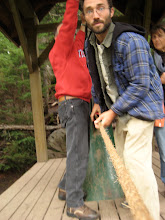Agroforestry notes - Thessaloniki Greece - 9/28/09 with Kostas Mantzanas
In Greece, 95% of forested land is public
Thus much is managed by the State Forest Service
anyone is allowed to graze public lands
this makes management oversight and coordination very challenging
The average precipitation in this part of Greece is 500-600mm and is generally distributed during the winter and early spring
This year to date, they’ve received 700mm and it’s been much more evenly distributed
The general grazing system has changed over the past 20 years
graziers have begun to supplement diets with grain to increase milk production
goats are not grazed intensively while cattle and sheep are
The Legadas Valley is the area north of Thessaloniki
it has deep(er) soils that formed from ancient lake bottom sediment
here, crops include maize, legumes, hay and cereal grains
In this area, the first frost generally comes around the end of November or late December - highly variable due to elevation and microclimate
The area around the ring road that surrounds Thessaloniki burnt in 1996
This area had previously been planted with Brutia and Aleppo Pine to help control erosion
This forest is managed for its ecosystem services
It has since been replanted with hardwoods which are less susceptible to fire
The community called Solvos is dominated by diverse woody perennial production including grape, walnut, cherry, peach
In the village of Askos the economy derives from livestock husbandry
In Sagarada, near Kissos, there is a 1000 year old plane tree (Platanus orientalis)
The EU today does provide subsidies to farmers to plant tree crops - started in 1992
As a result, you’ll see black locust and walnut plantations that have been established for timber
Generally, plantings are done in the winter months and trees are not provided irrigation
Kostas did his doctoral research monitoring the productivity of grass crop in the understory of pine forests. He compared the productivity of a native grass (Fallares aquatica) when fertilized with nitrogen fertilizer with that fertilized by legumes (Trifolium subterraneanum and Medicago lupulian) He found that the grass supported by legumes actually performed best
He also found that spacings of 500 trees/hectare were the most effective - often 3x6m apart with some open blocks
Also, Kostas revealed that his ideal agroforestry system would be a walnut-maize biculture
They had done studies that compared the productivity of walnut intercropped with maize and/or wheat and found that the walnut trees responded dramatically better when grown with maize. This is because the wheat is a winter crop and is not irrigated whereas the maize is grown in the summer and is irrigated at the same time that the walnut also needs water. They actually found that at spacings of about 100 trees per hectare (10x10 m spacings), walnuts grown with maize attained heights of 7 meters and diameters of 15cm in (I forgot how many) years while walnuts growth with wheat only grew to about 4 meters and 6 cm diameters. These systems ideally provide a 35 year sawlog harvest.
In areas used for silvopasture, the typical spacing is about 300 trees per hectare
There are approximately 18 species of oak found throughout Greece
Oaks are often managed by pollarding
For a tree with a typical life span of 80 years, a pollarded tree may attain 300 to 700 years
Germes Oak (Quercus coccifera) is a multi-stemmed shrub oak
it is valuable for livestock feed - especially goats who browse the leaves
it stays low to the ground and is often grazed down to a height of about 1/2 meter
this species is adapted to fire and would typically burn every 50-60 years
it’s growth is renewed very quickly after fire - about every 10 years
ideally there would be no grazing during that 10 year period but this is not the case
Quercus funeto (spelling?) is a favored tree for shredding and feeding to goats
Quercus pubescens - has a tree form
Olive trees are generally tolerant of sites at 300 meters or less
Some of the trees still under production can be up to 500 years old
Under typical conditions, these trees would average 30-40 year life spans
Olive trees in western Greece were planted by Venetians during their occupation
Trees were typically pollarded a 2 meter heights so they were out of the range of grazing goats
Chestnut Castanea sativa can generally be found at elevations about 500m
Juglans regia - the black walnut is prevalent throughout Greece
It is commonly known that walnut and grapes grow well together
In fact, many say that wine made from grapes grown amongst walnuts is more flavorful
In northwestern Greece, many old walnut trees are integrated with grape culture
Wild Pear - this is a native species with a small fruit that is often used as rootstock
When managed as such, almond trees are pollarded after 25-30 years
?Honey Locust - is more or less not present in Greece though they do use it in France
‘Caratonia cilica’ or something is a species native to south Greece that bears similar fruits and is adapted to the dry climate
Populus ligna and alba are the two primary native poplars
There is also a hybrid of the two
These are often planted in lowlands because they are faster growing and used for pulp production
During the last decade, the paper industry collapsed so the poplar market has dried up
Today they only use it as fuel
Phragmites is occasionally grown as a bedding crop for cattle
There are about three or four areas in Greece where apples are grown as a crop - the Pilion Peninsula is one of them
Ailanthus - common throughout Greece
planted as a soil stabilizer and for its fast growth
it’s not shade tolerant so tends to die out as a canopy develops
Acacia - legume with tiny pinnately compound leaves


No comments:
Post a Comment